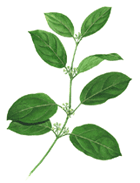Sorry … this is just a place holder, but stay tuned all the juicy details will be coming shortly.
“Gymnema takes away the desire to eat sweet foods, reduces the amount of sugar and carbohydrate that is digested from the food you eat, stimulates the production of insulin and increases cellular sensitivity to insulin. It has been shown in animal studies to reverse the damage that high blood sugar can do to the liver.”
Gymnema is a tropical forest vine native to central and southern India where it has been used in Ayurvedic medicine for almost 2000 years. Western scientists have been studying the effects of gymnema since the 1930s.

In the various Indian dialects, gymnema is referred to as:
Sanskrit: Meshasringi, Madhinasini or madhoolika,
Hindi: Gurmar,
Tamil/Malayalam: Sirukurinchaan(??????????????), Amudhapushpam, Chakkarakkolli.
When gymnema leaves are chewed, they appear to interfere with the taste receptors for sweet foods on your tongue leaving you unable to taste anything sweet for 15 minutes. It’s Hindi name literally means “sugar destroyer”.
Gymnema works in several ways:
It regenerates cells in the islets of Langerhans, specialised cells in the pancreas which produce insulin.
It stimulates the pancreas to produce more insulin.
It increases the activity of certain enzymes which help the cells to utilise glucose, increasing their sensitivity.
It increases the uptake of glucose into the muscles and cells of the body where it can be used for energy.
It reverses damage done to the liver by high blood sugar.
There have been many studies done over the past thirty years on the effects of Gymnema in both humans and animals. A study on rats found that Gymnema extracts doubled the number of insulin-secreting beta cells in the pancreas and returned blood sugars to almost normal. Other studies have found that Gymnema increases the activity of enzymes responsible for glucose uptake and utilization, and inhibits the peripheral utilization of glucose by somatotrophin (human growth hormone or HGH) and corticotrophin (which stimulates the adrenal cortex to produce and secrete adrenocortical hormones such as corticosteroids increasing stress response and inflammation).
Links & Further Information:
Gupta SS, Variyar MC. Experimental studies on pituitary diabetes IV. Effect of Gymnema sylvestre and Coccinia
indica against the hyperglycemia response of somatotropin and corticotrophin hormones. Indian J Med Res
1964;52:200-207
Murakami N, Murakami T, and Kadoya M. New hypoglycemic constituents in gymnemic acid from Gymnema sylvestre. Chem Pharm Bull 1996;44:469-471.
Shanmugasundaram KR, Panneerselvam C, Samudram P, Shanmugasundaram ER. Enzyme changes and glucose
utilisation in diabetic rabbits: the effect of Gymnema sylvestre, R.Br. J Ethnopharmacol 1983;7:205-234.
Shigematsu N, Asano R, and Okazaki M. Effect of administration with the extract of Gymnema sylvestre leaves on lipid metabolism in rats. Biol Pharm Bull 2001;24:713-717.
Shanmugasundaram ER, Rajeswari G, Baskaran K, et al. Use of Gymnema sylvestre leaf in the control of blood
glucose in insulin-dependent diabetes mellitus. J Ethnopharmacol 1990;30:281-294.
Shanmugasundaram ER, Gopinath KL. Shanmugasundaram KR, Rojendran VM. Possible regeneration of the
islets of Langerhans in streptozotocin-diabetic rats given Gymnema sylvestre leaf extracts. J Ethnopharmacol
1990;30:265-279.
Min BC, Sakamoto K. Influence of sweet suppressing agent on gustatory brain evoked potentials generated by taste stimuli. Appl Human Sci 1998;17:9-17.
Baskaran K, Ahamath BK, Shanmugasundaram KR, Shanmugasundaram ER. Antidiabetic effect of a leaf extract
from Gymnema sylvestre in non-insulin-dependent diabetes mellitus patients. J Ethnopharmacol 1990;30:295-305
Glaser D., Hellekant G, Brouwer JN, and Van der wel. H. (1984) Effects of Gymnemic Acid and on sweet taste perception in primates . Chemical Sciences 8,367-374.
Persaud SJ, Al-Majed H, Raman A, Jones PM. Gymnema sylvestre stimulates insulin secretion in vitro by enhanced membrane permeability. Journal of Endocrinology (1999) 163, 207-212 0022-00795/99/0163-107
http://joe.endocrinology-journals.org/cgi/reprint/163/2/207.pdf
Gymnema sylvestre. Altern Med Rev, 1999. 4(1): p. 46-7.